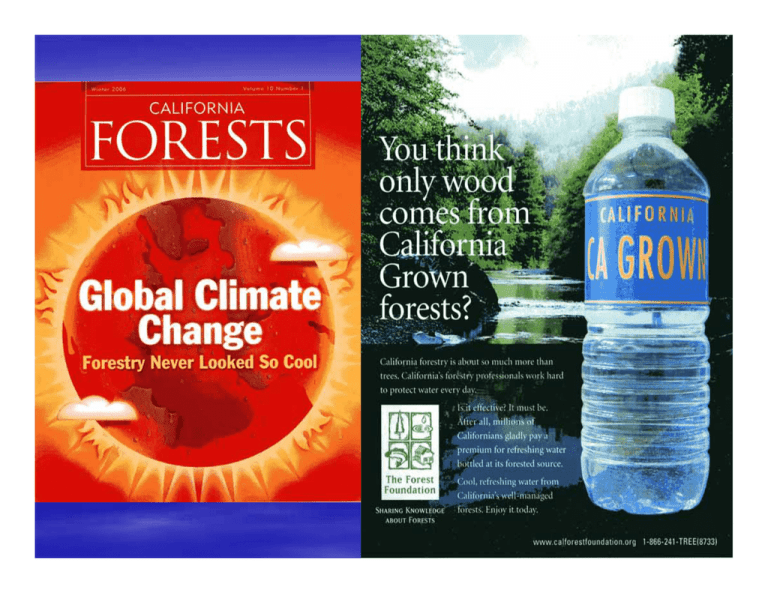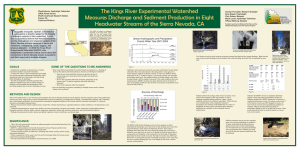Document 11369730
advertisement

Integrated Watershed Research Kings River Experimental Watershed Hydrology Meteorology Air quality Sediment & turbidity Soils & geomorphology Water chemistry Biology – – – – Stream macroinvertebrates Stream algae Riparian & upland vegetation Yosemite toad Potential Effects of CC on California Reduction of snowpack Changes in timing, intensity, location, amount, and variability of precipitation Changes in vegetation and increased incidence of wildfires Increased water temperatures Changes in human water demand – from Dept. of Water Resources 2006 California data for past 100 years Precipitation in central and southern – Slight decreasing trend Increased variability of precipitation Total annual water year runoff* – Sacramento rivers increasing – San Joaquin rivers decreasing April to July runoff – Sacramento rivers declined 9% – San Joaquin rivers declined 7% *Snowpack is 20% of State’s total runoff & 35% of useable surface water Predicted Loss of Snowpack (Knowles 2002) °C Increase 0.6 % Snowpack Loss 5 Year 2030 1.6 33 2060 2.1 50 (43 to 66)* 2090 *Effect greater in northern Sierra and Cascades 1983-2004 Tree Mortality in S.N. (van Mantgem & Stephenson 2007) Average mortality rate increased 3% a year – Nearly doubled for study period No evidence for changes in recruitment rate Correlates with stress and biotic causes – Temperature driven drought stress – Not mechanical or ozone stress Forests may be poised for die-back KREW: Sierra Nevada mixed conifer, semi-arid climate, perennial streams, high elevation, granite soils KREW STUDY AREA Part of the Kings River Sustainable Forest Ecosystem Project Teakettle Experimental Forest Stream discharge monitored intermittently since 1958. 6,725-8,090 feet elevation 560 acres KREW monitoring began WY2003 Climate Change and the Sierra Nevada • Approximate 1-2 °C rise in average temperature since 1940’s • Models predict additional 2.5 to 9 °C rise by 2100 • This will cause: 1. More winter precipitation falling as rain instead of snow 2. Faster rate of snowmelt 3. Earlier snowmelt The end result is: Less water for California ! From: Peterson, et. al. “Snowmelt discharge characteristics Sierra Nevada, California”. US Geological Survey Publication SIR-20055056, 2003. Stream Flow and Snow Depth From Providence Creek (6500 ft) and Bull Creek (8100 ft) - 2004-2007 175 15 125 Snow Depth Stream Flow Providence Creek Site - P303 Stream 10 75 50 5 25 0 Oct-2003 0 Jan-2004 Apr-2004 Jul-2004 Oct-2004 Jan-2005 Apr-2005 Jul-2005 Oct-2005 Jan-2006 Apr-2006 Jul-2006 Oct-2006 Jan-2007 Apr-2007 Jul-2007 20 Stream Flow (Cubic Feet per Sec) 100 Snow Depth (inches) 150 Oct-2007 175 150 15 125 Snow Depth Stream Flow 10 Bull Creek Site - B203 Stream 100 75 50 5 25 0 Oct-2003 0 Jan-2004 Apr-2004 Jul-2004 Oct-2004 Jan-2005 Apr-2005 Jul-2005 Oct-2005 Jan-2006 Apr-2006 Jul-2006 Oct-2006 Jan-2007 Apr-2007 Jul-2007 Oct-2007 Snow Depth (inches) Stream Flow (Cubic Feet per Sec) 20 Cumulative discharge for KREW, water year 2004. Fraction of annual discharge 1.0 0.8 0.6 D102 P301 B204 0.4 0.2 0.0 Oct 1 Dec 1 Feb 1 Apr 1 Jun 1 Aug 1 Oct 1 WestWide Climate Change Initiative Ron Neilson’s modeling work – DGVM, MC1 – Temperature min & max, relative humidity MS students working on 800-m grid resolution – Maureen McGlinchy for my study area Kings River Experimental Watershed is made possible by: National Fire Plan Joint Fire Science Program USDA Forest Service, PSW Research Station and Region 5 California Bay-Delta Program (CalFed) Southern California Edison Univ. of Calif., Santa Barbara, Merced, Berkeley, Davis, Irvine Univ. of Nevada, Reno Colorado State University, Ft. Collins Calif. State Univ., Fresno






